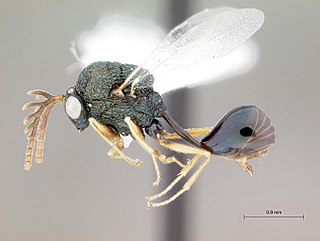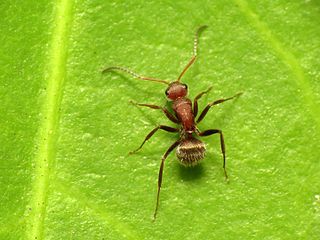
The Eucharitidae are a family of parasitic wasps. Eucharitid wasps are members of the superfamily Chalcidoidea and consist of three subfamilies: Oraseminae, Eucharitinae, and Gollumiellinae. Most of the 55 genera and 417 species of Eucharitidae are members of the subfamilies Oraseminae and Eucharitinae, and are found in tropical regions of the world.

Gustav L. Mayr was an Austrian entomologist and professor in Budapest and Vienna. He specialised in Hymenoptera, being particularly known for his studies of ants.

Aphaenogaster is a genus of myrmicine ants. About 200 species have been described, including 18 fossil species. They occur worldwide except in South America south of Colombia, sub-Saharan Africa, and Antarctica.

Ochetellus glaber is a species of ant native to Australia. A member of the genus Ochetellus in the subfamily Dolichoderinae, it was described by Austrian entomologist Gustav Mayr in 1862. Aside from Australia, O. glaber has been introduced to a number of countries, including China, India, Japan, New Zealand, the Philippines and the United States, where it has established itself in Hawaii and Florida. It has been found on Lord Howe Island, New Caledonia, Norfolk Island, Réunion and the Solomon Islands. Compared with other ants, O. glaber is a small species, with workers measuring 2–3 mm (0.079–0.118 in). Males are the smallest at 1.6 mm (0.063 in), while the queens measure 5.2–5.5 mm (0.20–0.22 in). The ant's colour ranges from brown to black.

Aphaenogaster amphioceanica is an extinct species of ant in the subfamily Myrmicinae known from a single possibly Miocene fossil found in amber on Hispaniola. At the time of description A. amphioceanica was one of two Aphaenogaster species known from the Caribbean islands.
Aphaenogaster praerelicta is an extinct species of ant in the subfamily Myrmicinae known from a solitary Late Oligocene to Early Miocene fossil found in Mexico. At the time of description A. praerelicta was one of three Aphaenogaster species known from Mexico.
Malagidris is a Malagasy genus of ants in the subfamily Myrmicinae. Described in 2014, the genus contains six species.

Aphaenogaster longaeva is an extinct species of ant in formicid subfamily Myrmicinae known from a solitary Eocene or Oligocene fossil found in North America. A. longaeva was one of five insect species described by the paleoentomologist Samuel Hubbard Scudder in an 1877 paper.

Novomessor ensifer is a species of ant endemic to Mexico. A member of the genus Novomessor in the subfamily Myrmicinae, it was first described by Swiss entomologist Auguste Forel in 1899. N. ensifer was originally a part of the genus Aphaenogaster until a recent phylogenetic study concluded that Novomessor was genetically distinct and should be separated. The ant is a medium-sized species, measuring 5.5 to 10 millimetres. The ant is ferruginous-colored in some certain parts of the body, and small workers (nanitics) in incipient colonies are noticeably different in color and body structure.

Novomessor albisetosus, also known as the desert harvester ant, is a species of ant found in the United States and Mexico. A member of the genus Novomessor in the subfamily Myrmicinae, it was first described by Austrian entomologist Gustav Mayr in 1886. It was originally placed in the genus Aphaenogaster, but a recent phylogenetic study concluded that it is genetically distinct and should be separated. It is a medium-sized species, measuring 6 to 8.5 millimeters and has a ferruginous body color. It can be distinguished from other Novomessor species by its shorter head and subparallel eyes.
Aneuretellus is an extinct genus of ant in the formicid subfamily Aneuretinae, and is one of eight genera of the subfamily. The genus contains a single described species Aneuretellus deformis and is known from one Middle Eocene fossil which was found in Sakhalin in the Russian Far East.

Tetramorium hispidum is a species of ant in the subfamily Myrmicinae. Tetramorium hispidum differs from similar ants in the Myrmicinae subfamily by the structure surrounding the ant's antennal insertions. Short, stubble-like hairs exist on the pronotum and frontal carinae. The antenna of Tetramorium hispidum contains 11 segments.

Camponotus sexguttatus is a species of ant in the family Formicidae.

Camponotus planatus, known generally as the compact carpenter ant or short carpenter ant, is one of three Camponotus species that is polygynous, it also is a species of ant in the family Formicidae.

Pheidole metallescens is an ant, a species of higher myrmicine in the family Formicidae.

Trachymyrmex nogalensis is a species of higher myrmicine in the family Formicidae.

Camponotus quercicola is a species of ant in the family Formicidae that is endemic to California and commonly nests in oak trees, as they usually inhabit oak forests.
















